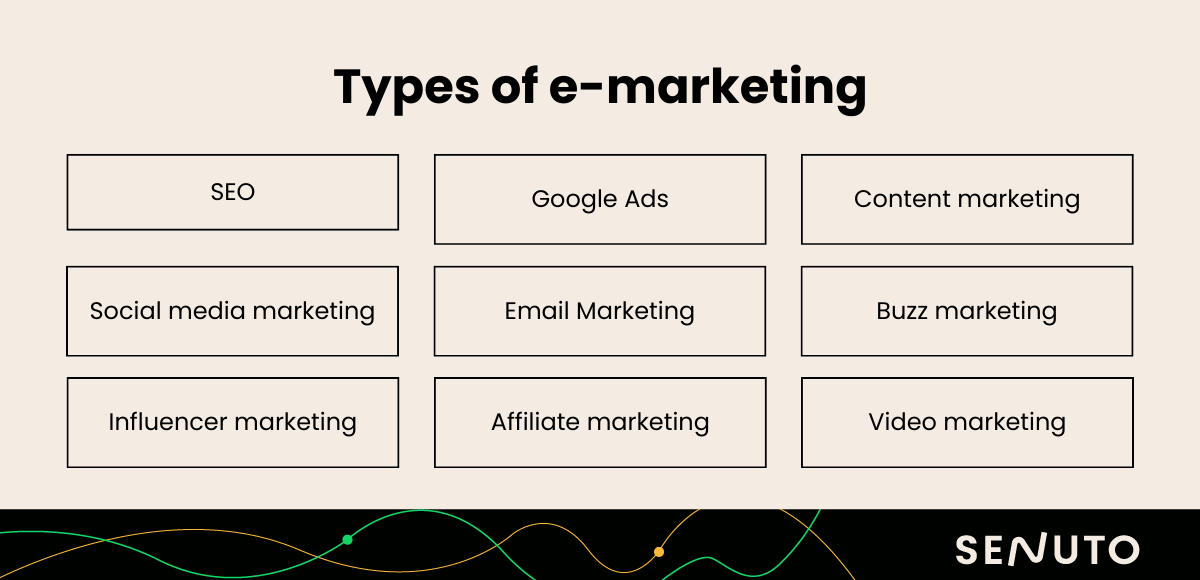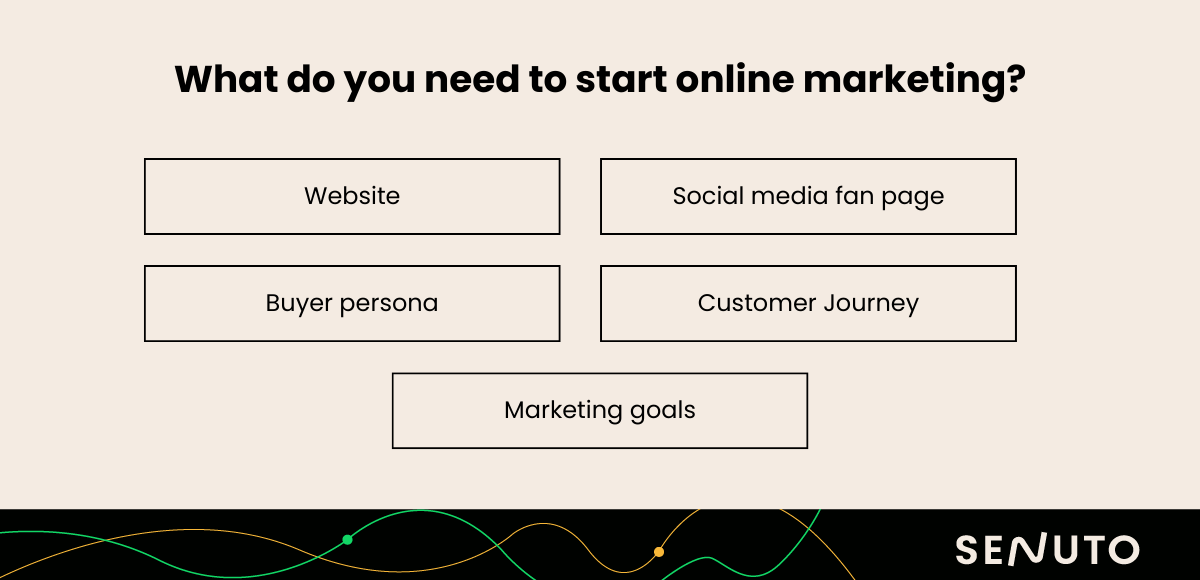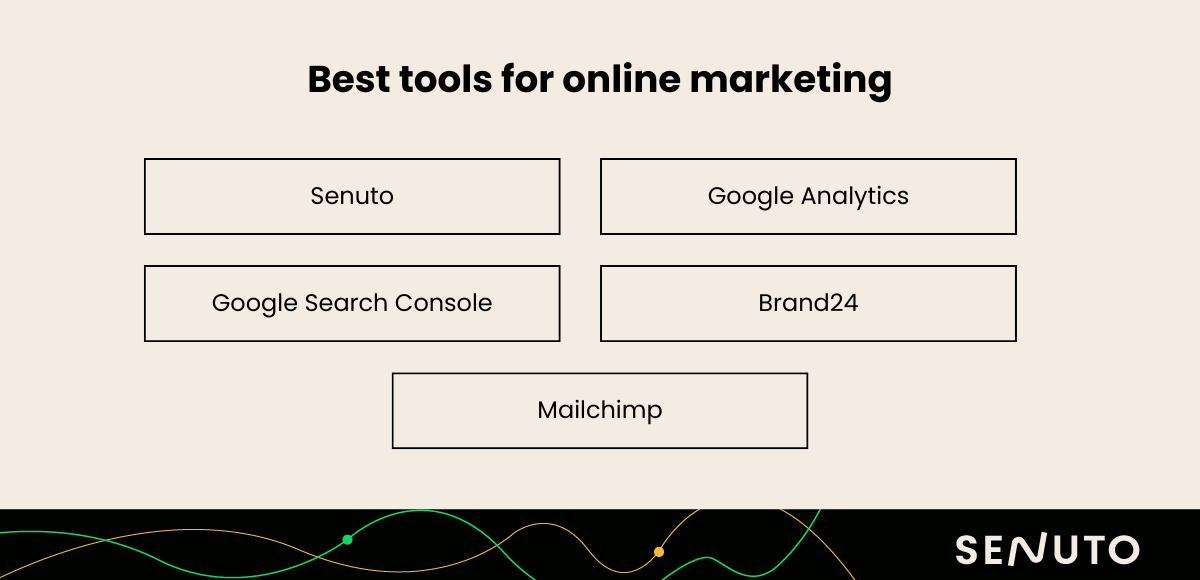Online marketing is a huge topic. Are you here to find out what e-marketing is and how to get started growing your business online? Great, the sooner the better! The internet offers many possibilities – if you are engaged in traditional marketing, it’s smart to at least partially shift your budget online. I will show you how – welcome!
What is online marketing?
Online marketing is the sum of all advertising activities a brand can do on the internet. Unlike offline marketing, it allows for full personalization of the advertising message, detailed analysis of the effects, and optimization based on data.
Online marketing vs. offline marketing
Marketing comes in many flavors: ATL, BTL, content marketing, buzz marketing, multi-level marketing… I could go on forever.
But the best way to divide the ways a brand can promote itself is into those that take place on the internet (called online marketing or e-marketing) and offline (traditional marketing).
✅ Traditional marketing activities include:
- TV and radio advertisements
- advertisements in the press
- outdoor advertisements (billboards, advertising posters, murals, advertisements on electronic displays, e.g. in public transport)
- participation in conferences and trade fairs
- giveaway (all kinds of branded gadgets: key rings, T-shirts, stickers, pens, etc.
- flyers and brochures
Advertising in traditional media that doesn’t allow message personalization is known as ATL (above the line) marketing. These types of activities are carried out on a large scale without characterizing the target group (ads on TV can be seen by anyone who happens to tune in).
Offline marketing has its advantages as well as disadvantages. But it really pales in comparison to e-marketing.
✅ What are the disadvantages of traditional marketing?
- one-way contact with the consumer, no possibility of feedback
- limited ways of personalizing the message
- poor knowledge about the customer
- predominance of “push”-type messages (as opposed to “pull” – more on that later)
- high costs (especially for TV advertising)
- inability to perform accurate and quick effectiveness measurements
✅ What does online marketing say to that?
Compared to traditional marketing, online marketing gives you more room to maneuver. Not only does it enable full personalization of advertising formats and messages, but also allows you to thoroughly check the results of conducted campaigns. Knowing their effects, you can optimize and scale them.
Most online marketing formats are BTL (below the line). BTL strategies assume targeting a specific group, which is relatively easy to achieve online.
When marketing on the internet, you also have a broad range of tools at your disposal which will help you get to know your target group better. Knowing where they spend their time and exchange knowledge, how they look for information and products/services, you can adjust your message and channel of communication. This, in turn, allows you to apply pull marketing techniques (inbound marketing) that are more effective than push techniques.
Moreover, compared to traditional marketing, online marketing usually costs much less. Of course, it all depends on the scale of your campaign – if you want, you can spend all the money in the world online. But to get started, you don’t have to spend your whole budget right away.
The internet is also fertile ground for test marketing. If you’re just starting out with online marketing, you can try different ad formats and placements (more on that below). Choose some for your business and see what works best.
EXAMPLE:
If you run a small store of scented soy candles, start with paid advertising on social media. Invest USD 100 in advertising on Instagram and Facebook. Keep this up for 2–3 months and then analyze what gave better results overall. Which type of advertising brings you more sales?
Once you’ve checked what works better, run more tests – try Google Ads and SEO. However, keep in mind that, by design, paid ads in Google give immediate results, while SEO results pay off in the long run.
Note! When choosing online channels to promote your business, see what your competitors are using. If they’ve been advertising through a given channel for a long time, it’s a clear sign that it’s worth trying!
More tips you could use: Blog positioning – how to go about it? You will find some rules there that are useful not only on your blog, but on all pages where you post content.
Online marketing goals
Goals in online marketing differ depending on the type of business. However, the overriding goal of any company is always to generate sales. Let’s consider this as the end goal, with many steps leading to it – different steps depending on where the customer is on the customer journey.
Examples of e-marketing goals:
- generating traffic on the website – organic: e.g. using SEO; or paid, e.g. using Google Ads, display ads (banners), Facebook Ads.
- increasing brand awareness
- increasing the brand’s online presence
- building a community
- building a contact database – in other words: collecting leads (contact details of people who may be potentially interested in your product/service)
- customer education
- building company authority
- acquiring customers from new segments
- increasing customer satisfaction
- increasing customer loyalty
Online advertising – types of e-marketing
There are plenty of possibilities for advertising on the internet! For this reason, it is worth diversifying your approaches in online marketing. Here are the most popular types of activities:

✅ SEO – page optimization in the Google search engine
SEO (Search Engine Optimization), in other words, online marketing done through the Google search engine, is about generating organic traffic from search results. It is a set of activities that have one goal – to increase the visibility of your website on Google so that it appears for as many keywords as possible, with the highest possible rank. You should aim for TOP 10, or even TOP 3.
You must choose keywords according to your business profile – if you sell clothes, phrases should be related to the theme of fashion; if you run a tourism portal – with travel.
Note! Google search results show organic (SEO) and paid (Google Ads) results. In the case of SEO, you do not pay when a user clicks on your link, and in the case of Google Ads, every click costs you money.
Check our SEO beginner’s guide, in which we describe how to approach optimizing your website. Perhaps you will find it useful.
✅ Google Ads
Google Ads is a Google brand advertising system where you can set a paid ad in search results and on pages that belong to the AdSense program (blogs, thematic portals, as well as other Google products, including YouTube or Gmail).
Adverts are be displayed in Google above or below the organic results (you can find yourself among the latter through SEO). Choose the keywords for which the ad is to be displayed, prepare the text and/or banner and… bid. You do not pay for the mere display of your result, but for the user clicking on it.
You can learn more about how advertising works in Google Ads in the article on PPC (pay per click).
The bottom line is, SEO and Google Ads complement each other. Together, they are known as SEM, Search Engine Marketing.
✅ Content marketing
Marketing focused on content is a strategy that has been steadily gaining popularity for years. This form of online advertising includes, for example:
- company blogs,
- sponsored articles,
- expert articles,
- webinars,
- infographics,
- rankings,
- industry sector reports,
- case studies and use studies,
- tutorials,
- courses,
- interviews,
- podcasts,
- e-books,
- guides,
- films and animations (video marketing),
I find this area fascinating, which is why I chose content marketing as my specialization. Why do I believe it holds so much promise?
Content marketing is about publishing and distributing content that is useful to users (potential customers). It is a pull strategy, not push – the user voluntarily opens/downloads your content. Unlike an advertisement on TV, radio, or a billboard by a highway, the user is not forced to see or hear it. On the contrary – sometimes they ask for it themselves, e.g. on Google.
Content allows you, as a brand, to accompany the user at every stage of the sales funnel. Content will work great on top of the funnel (TOFU), in the middle (MOFU) and at the bottom (BOFU).
✅ Social media marketing
Social media marketing includes advertising on Facebook, LinkedIn, Instagram, YouTube, Twitter, etc. Why is it worth doing? If only because many people treat social media both as a place of entertainment, a source of information about the world, and a platform for contact with friends and brands. This means we all spend a lot of time there, and so do your potential customers. And you want to be where they are, right?
So use the potential of social media marketing! Check where people from your target group visit most often – look for them on thematic groups or popular profiles, meet micro-influencers, and join the discussion.
How to start social media marketing? Here is the shortest cheat sheet in the world:
- First, create a fan page on Facebook or another medium and carefully fill out the information about the brand. Add a link to your website, describe what the company does, upload the main photo and cover art.
- Start publishing interesting content (e.g. blog articles, live video), steadily growing your group of fans. However, keep in mind that the number of likes is currently not a decisive result of the success of your profile. It’s important to build a community around it, so encourage your fans to comment, like, and share your posts. All types of reactions increase your brand-customer bond.
- You can also set up a group on Facebook and LinkedIn. Many brands do it – with great success! They build their own communities there, which are easier for them to reach than through a fan page.
Also by making an intro video with InVideo, you can introduce yourself, your team, and your business to the world in a way that is engaging, informative, and visually appealing. Your video can be posted on your website, social media channels, or even shared with potential clients, partners, or investors.
✅ Email Marketing
Marketing based on email has been laid in the grave more than once. It turns out, it’s alive and well!
Email is a great channel for direct marketing. After all, your messages go straight to the place that most users check on an ongoing basis – when they wake up, on the bus, over lunch.
Consequently, communication based on email is considered very personal. One of the reasons is that you cannot currently send users email messages without their consent (GDPR). Once you’ve got consent, however, it’s clear that you’ve won their trust, and that really counts.
Additionally, an advertising strategy based on email marketing is relatively inexpensive. This makes it useful both for young companies and experienced market giants.
Email is also useful because you can analyze results as you go. You can see who clicked what, how many times the email was opened, what the conversion was. You just have to stick to a few basic rules, such as “one call-to-action (CTA) per mail”. You’ll be also happy to hear that skillfully implemented email marketing shows a great return on investment (ROI).
✅ Buzz marketing
Buzz marketing, also known as word-of-mouth marketing, is a form of online advertising that is still fully applicable in today’s strategies. I say “still” because buzz marketing is often reduced to spamming and as such gives poor results. This does not mean, however, that it has no potential – quite the opposite!
Buzz marketing involves putting comments and posts on forums, groups, as well as on Quora (a website where users ask questions on various topics and get answers to them). These entries are designed to invoke positive reactions about the brand and spark a discussion around its products. Other buzz marketing goals include generating traffic on the website and acquiring links (important in terms of SEO).
How to conduct online marketing?
An online marketing strategy usually combines various forms of advertising. Brands combine content marketing with SEO (as they should!), SEO with Google Ads, and SEM with social media marketing. That’s smart, but depending on the type of business, it’s worth considering which channel deserves most of your budget.
You can start your online marketing activities on your own or outsource them. There are many independent specialists and experienced agencies on the market that will be happy to prepare a marketing strategy for your business.
And so we’ve come to the strategy. Without it, it’s hard to get quick results.
How to prepare an online marketing strategy for a brand? First, you need to know the possibilities that the internet offers in this area, and then match them to your business and target group. If you’re just getting started, there’s a lot of learning to do. If you don’t want to or don’t have the time, consider outsourcing these activities to an agency.
What do you need to start online marketing?

✅ Website
The website is the lynchpin of your online marketing activities. If you want to advertise your business online, build a place where you can direct potential new customers.
✅ Social media fan page
When promoting your company on the web, brand profiles on social media are also worth creating.
Currently, the primary medium for brand advertisement is Facebook. Create your fan page there to communicate with your customers and inform them about things like new products. Without a brand profile on Facebook, you won’t be able to advertise there.
Remember to choose the medium appropriate for communicating with your target group – if your business is fashion or interior design, you certainly can’t miss Instagram!
If you direct your products/services mainly to the B2B sector (business-to-business, i.e. to other companies), create a brand account on LinkedIn.
✅ Persona
Let’s stay for a moment on the subject of the target group. A persona is a related concept. You will often come across it if you set out to learn about online marketing.
A persona is an exemplary person from your target group, whom you name, define their age, characteristics, preferences, as well as their way of spending free time and their work life. You derive all this from hard data gathered by analytical tools at your disposal (e.g. CRM) and your sales experiences so far. For what purpose?
To direct all your activities on the internet to this persona. Not only will it make it easier for you to write content that will grab the customer’s heart (and mind, of course!), but also make it easier for you to pick the channels and methods of communication.
Highlighting the differences between online and offline marketing at the start of the article, I emphasized the broad possibilities of personalizing advertising messages in online activities. The persona is a tool that will make this task much easier for you!
✅ And finally… the customer journey
Describing the stages of the customer journey is good practice in online marketing. I’d even say it is a very good practice and your business will be served best if you take care of it right away. What is the customer journey and why am I so positive you should prepare it?
Customer journey is composed of all the stages that the user goes through on the way to purchase. As a standard, 5 such steps are listed:
- building awareness (“I want”) – the user becomes aware of their need,
- consideration (“I’m looking”) – they compare different models and read reviews,
- acquisition (“I buy!”) – they make the decision to buy,
- service (“I use”) – the customer uses the product,
- loyalty (“I recommend!”) – the customer is happy and recommends the product to their friends.
However, be aware that depending on the type of business, there may be more stages. It is also possible that they will be slightly different from those listed above.
Thanks to the knowledge of your customer’s journey, you can accompany them at every stage. This way, you can consciously plan the content and advertising on individual channels to first attract a potential customer and then hold on to them.
Search engine traffic is one of the most important sources of website traffic
SEM is one of the main sources of traffic on websites. What’s more, such traffic converts very well. Why? There are at least a few reasons:
- By entering the phrase in Google, the user expresses purchase intent – directly (“mtb bike price”) or indirectly (“what bike for a child”). This means that when you are visible in top search results, you do not push your advertising message uninvited, but answer the user’s query (a.k.a. pull).
- Google accompanies most of us throughout our waking lives. We are looking for products, services, and answers to our questions on the internet. Where would your client be, if not there?
- Optimization boosts brand awareness. So you kill two birds with one stone.
Simply put, when your business comes up in the search results for relevant keywords, it allows you to reach your potential customers with your offer. What’s more – those customers are often ready to buy. How does it work in practice? Check out the examples below:
EXAMPLE 1
You run an online wine store. When a user enters the phrase “which wine for dinner” or “what wine for a wedding” on Google, they become your potential customer. Their inquiries directly reveal purchasing intent. However, before this user makes the purchase, they have to decide on a specific product. You should create content that will help them make that choice and make it appear in the top search results for specific phrases.
Check how to write Google-friendly blog posts to boost your rank in Google!
Note! Propose products from your offer in the content. Ideally, you should persuade the customer to buy wine in your own store!
EXAMPLE 2
The user enters the phrase “massage Louisville” in Google because they dream of a relaxing massage after a long week’s work or their back hurts from an ill-fitted chair. Masseur in Louisville wanted! Do you provide such services? If so, you positively must appear on Google after this phrase is typed! Do what you can to fit into the top ten results.
Remember! Especially if you only operate in one city or region, a Google My Business profile will come in handy. Find out how optimization works on Google Maps.
Tools for online marketing
From the get go, your marketing activities should rely on tools that will equip you with the most important data on advertising results. You don’t need a lot at first, but there are a few basic ones which are essential for effectiveness.
✅ Google Analytics
Google Analytics (GA) is a basic tool for analyzing website traffic and user behavior on a website. You can check how many people are on the website in real time, how many subpages a user visits during one session, and how much time they spend on the website. GA also lets you see which pages are most visited by users and have the best conversion.
That’s just the start, of course. GA will also allow you to better understand your users, their interests and behaviors. It is also a rich source of knowledge about what users are doing on your website. Google Analytics should be implemented as soon as your website sees the light of day – even if you can glean little from this data at the beginning.
Note! Google Analytics is free and available to everyone. To run it, you need to paste a special script snippet (which you can download from the GA panel) in your website’s code.
✅ Google Search Console
Another free tool from Google is Google Search Console (GSC), which lets you analyze the traffic on the website that comes from the Google search engine. There you can see the indexation status (crawls by Google bots) broken down by individual subpages, and detect technical problems (e.g. 404 errors).
✅ Senuto
Above, I explained why high visibility of your website on Google is so important for your business. People who are looking for the products or services you offer are already there, asking for them and wanting to buy them. Give them this opportunity!
The main way to work with Google is with keywords, and these you can find in Senuto. Numerous reports will also show you what your situation looks like in terms of organic results. You will learn which keywords put your website in the TOP 10 and TOP 3 search results, how you rank against the competition, and how your rank increases (or drops) on Google.
No such thing as bad publicity! Whether or not you agree with this statement, it’s important to know the context where your brand is mentioned.
If someone mentions you on a forum, in their article, in a Facebook post, in a comment or a podcast – Brand24 will let you know about it. If someone asks about your brand, your competitor, or the products you sell, you should join the conversation as soon as possible. Social listening is a good way to reach your customers on different channels.
✅ Freshmail, Mailchimp, or GetResponse
As soon as you start marketing online, you should be collecting leads, i.e. contacts (usually email addresses) of people potentially interested in your product. This will allow you to “nurture” them, e.g. by sending a newsletter. You can prepare and send it using tools such as Freshmail, Mailchimp, or GetResponse.

Anything missing? Write us a comment about what else should be in this article!
 Karolina Matyska
Karolina Matyska